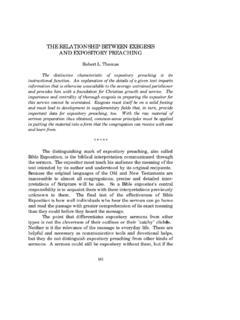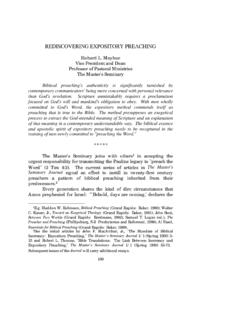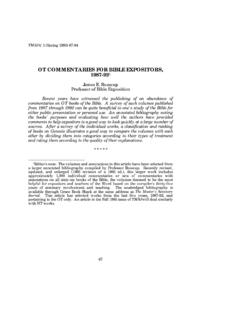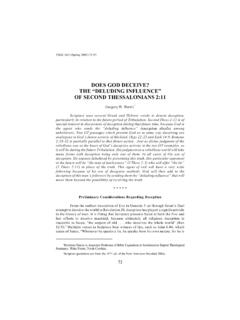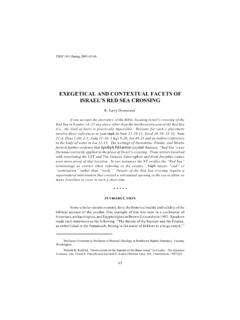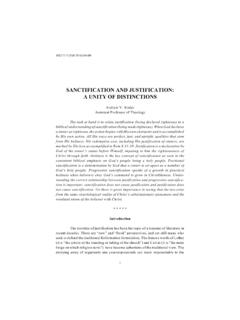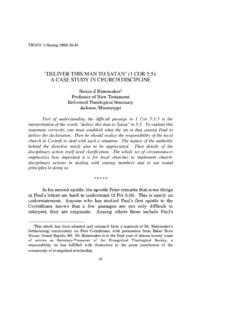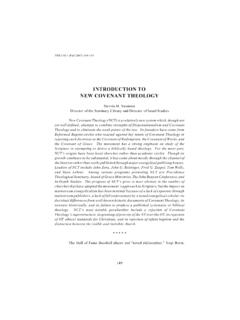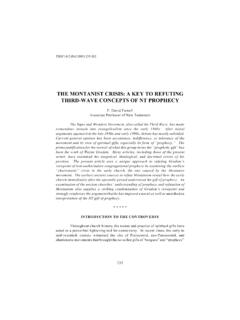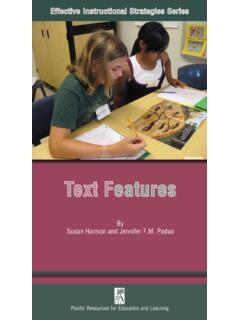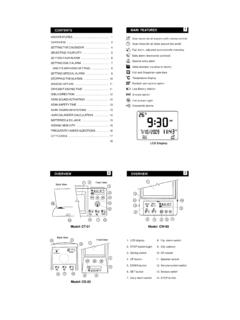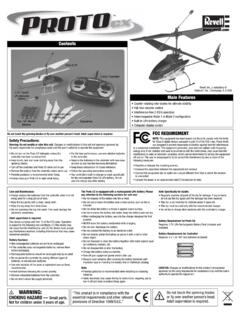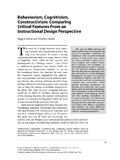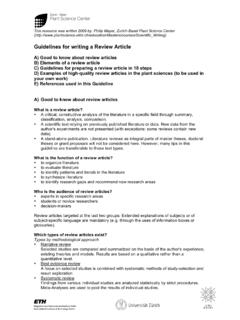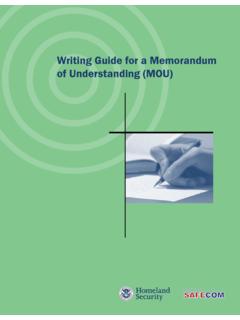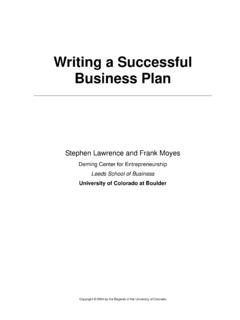Transcription of THE MAIN THEME AND STRUCTURE OF JAMES
1 115 THE main THEME AND STRUCTURE OF JAMES William C. Varner, Professor of Biblical Studies The Master s College The Letter of JAMES has played an important role in the expository and polemical ministry of John MacArthur. In addition to his commentary on JAMES , Dr. MacArthur has utilized JAMES 2 in The Gospel According to the Apostles as a lynchpin in his argument about true saving faith. The THEME and STRUCTURE of JAMES is offered in appreciation for his ministry that has always stressed, like JAMES , the authenticity of saving faith. ** For over four centuries, discussion about the STRUCTURE of JAMES letter could be referred to as commentary on A German Tale of Two Martins. Those two influential Germans were Martin Luther in the sixteenth century and Martin Dibelius in the twentieth century.
2 Both could see no coherent STRUCTURE in this book. While there were others who voiced exception to the views of the two Martins, their pervasive influence has certainly dominated the discussion for far too long! Luther s comment about JAMES being an epistle of straw, as compared to the theological signifiance of Paul s writings, is his most well-known comment on the His views about the style and STRUCTURE of JAMES , however, were equally negative. Discounting apostolic authorship, Luther concluded that the author must have been some good, pious man, who took a few sayings from the disciples of the apostles and thus tossed them off on paper. 2 Even if we discount his anachronistic comment about paper, since that medium was not invented until the late Middle Ages, his stinging indictment of JAMES style remains.
3 To Luther this letter was not written by JAMES the Lord s brother, and it is totally disorganized in its presentation of the few sayings he did borrow from the apostles. Furthermore, in his erudite commentary, Martin Dibelius concluded from his form critical analysis that JAMES contained no overall thematic or 1 Luther s expression could be more literally rendered a right strawy epistle (eyn rechte stroern Epistel). Luther s Works (St. Louis, MO: Concordia, 1972), 35: 362. Hereafter referred to as LW. 2 LW, 35: 397. MSJ 22/1 (Spring 2011) 115-129 The Master s Seminary Journal 116 structural He did acknowledge that three individual treatises (2:1-13; 2:14-26; 3:1-13), which he called the core of the writing, were fairly coherent in their diatribal style.
4 But the rest of the book, however, was primarily composed of loosely arranged sayings, sometimes connected by catch words, in the style of what Dibelius referred to as Jewish Dibelius influence on later writers is undeniable and Among recent writers who have discerned some measure of coherence in the epistle s STRUCTURE , many often stress the key role of chapter one in serving as a sort of table of contents for the rest of the Others have argued more specifically that 1:19 ( be swift to hear, slow to speak, slow to anger ) comprises a three-point outline of chapters Despite this recent trend toward seeing greater coherence, Taylor and Guthrie recently concluded that no consensus has emerged concerning the details of the book s organization.
5 8 3 M. Dibelius, JAMES , rev. H. Greeven; trans. M. A. Williams (Philadelphia: Fortress, 1976), 34-38. 4 Ibid., 1-10. 5 For discussions by various writers on the literary STRUCTURE and genre of JAMES , see Johnson, The Letter of JAMES AB (New York: Doubleday, 1995), 37A:11-25; P. H. Davids, The Epistle of JAMES in Modern Discussion, ANRW II (25:5): 3621-45; M. E. Taylor, Recent Scholarship on the STRUCTURE of JAMES , CBR 3:1 (2004): 86-115. 6 Johnson, JAMES , 15; R. Bauckham, JAMES (London: Routledge, 1999), 68-73. Bauckham, however, along with Moo observe that the great diversity among the proposed structures for the epistle may indicate that there is no clearly discernible STRUCTURE to the book.
6 Moo opts for an overall concern rather than a structured THEME . That concern is JAMES desire for spiritual wholeness. D. J. Moo, The Letter of JAMES in PNTC (Grand Rapids: Eerdmans, 2000), 44, 46. 7 An early advocate of this approach was H. J. Cladder, Die Anlage des Jakobusbriefes, ZTK 28 (1904): 37-57. More recent advocates are Z. C. Hodges, The Epistle of JAMES : Proven Character Through Testing (Dallas: Grace Evangelical Society, 1994) and R. W. Wall, Community of the Wise: The Letter of JAMES in NTC (Valley Forge, PA: Trinity, 1997), 35-37. 8 M. E. Taylor and G. H. Guthrie, The STRUCTURE of JAMES , CBQ 68:4 (2006): 681-705. Taylor and Guthrie s approach recognizes the role of organizing principles such as the double opening section, the presence of inclusios, the use of aphorisms, and the presence of summary expressions.
7 Their conclusions leave an epistle that has a very long introduction and body opening (1:1-2:11) plus an equally long body closing and conclusion (4:13-5:20), enclosing a body proper consisting only of 2:12-4:12. In addition to the book thus having a body shorter than its opening and conclusion, their analysis seems to have so many organizing principles that very little in the book is actually prominent since so many individual elements are supposed to be prominent. I have coined the expression ber analysis for this tendency to over analyze a text by imagining too many literary characteristics. Furthermore, their lack of discerning one controlling THEME in the midst of such an involved analysis is a considerable weakness of their proposal.
8 I have chosen to comment on Taylor and Guthrie s approach because it illustrates what so many have failed to accomplish in their proposals about the book s STRUCTURE : an analysis based on all that the text teaches that enables the reader to form a mental representation of the discourse in as simple a way as the discourse allows. For the most recent scholarly efforts in this area, see the thorough study by L. Cheung, The Genre, Composition and Hermeneutics of the Epistle of JAMES (Milton Keynes, England: Paternoster, 2003) and M. E. Taylor, A Text-Linguistic Investigation into the Discourse STRUCTURE of JAMES (London: T&T Clark, 2006). The main THEME and STRUCTURE of JAMES 117 With so many differences about the book s STRUCTURE among scholars past and present, what hope is there that we can ever discern an overarching strategy in its composition?
9 Or, should we just conclude that there is no evident overall strategy and be satisfied with arranging by intuition JAMES discrete topics in a linear list? I am convinced that an analysis of this book that gives attention both to how authors indicate prominence and to how they group their messages offers fresh hope that we can then uncover the STRUCTURE of this little book which actually helps to convey its overall message. A PROPOSAL ABOUT JAMES 3:13 18 By applying the techniques of cohesion, prominence, peak, and grouping to the text of JAMES , I propose that JAMES 3:13-18 is the peak of his discourse. And as the peak, this crucial passage highlights the primary concerns of the author.
10 How does JAMES focus his spotlight on this section and give it the frontground prominence over other sections of his discourse? I have leaned heavily on the insights on prominence developed by Stanley Porter and the insights on peak developed by Robert Longacre. These scholars have pioneered this approach in their formidable works on linguistics and Biblical This section (3:13-18) fits all the expectations for its being dissimilar to the rest of JAMES encyclical letter. In other words it sticks out as a peak from the surrounding hills of the letter. It functions as the most prominent section of the book, and is like a zone of turbulence compared to the other important but less prominent sections.
